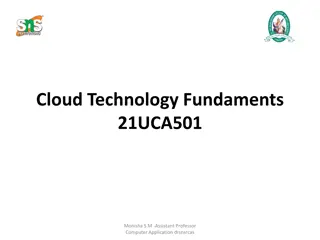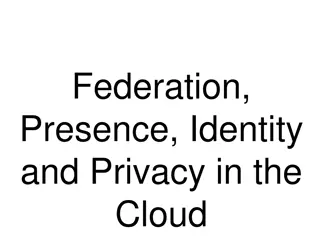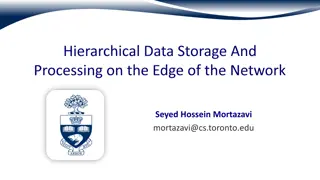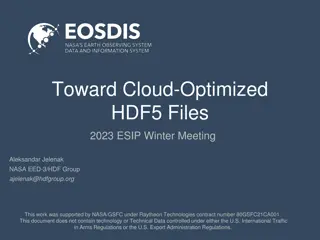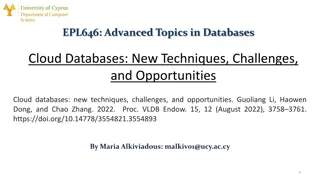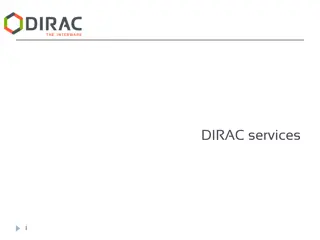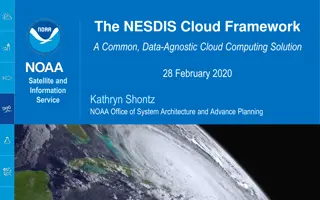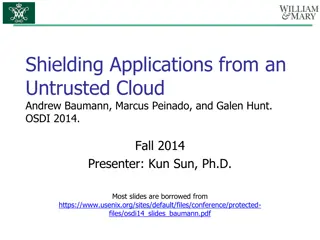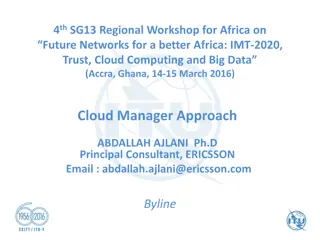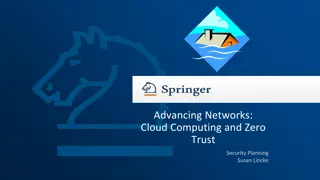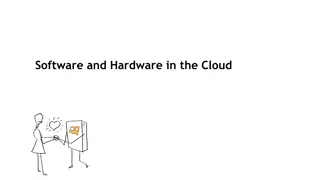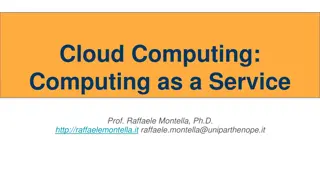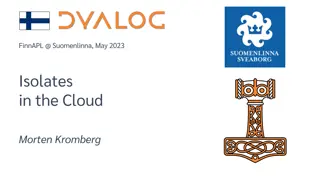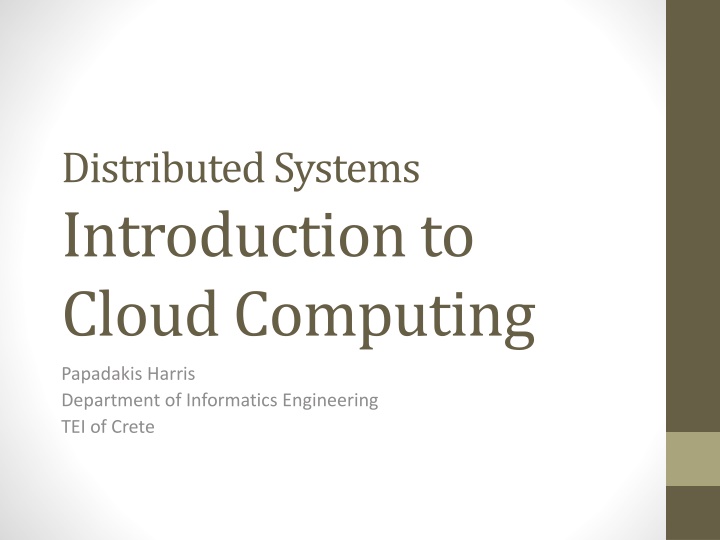
Cloud Computing Categories and Services Overview
Explore the fundamentals of cloud computing, including Software as a Service (SaaS), Platform as a Service (PaaS), and Infrastructure as a Service (IaaS). Learn about different maturity levels in SaaS, integrated computing platforms in PaaS, and processing infrastructures in IaaS. Discover examples and key concepts driving the cloud computing landscape.
Download Presentation

Please find below an Image/Link to download the presentation.
The content on the website is provided AS IS for your information and personal use only. It may not be sold, licensed, or shared on other websites without obtaining consent from the author. If you encounter any issues during the download, it is possible that the publisher has removed the file from their server.
You are allowed to download the files provided on this website for personal or commercial use, subject to the condition that they are used lawfully. All files are the property of their respective owners.
The content on the website is provided AS IS for your information and personal use only. It may not be sold, licensed, or shared on other websites without obtaining consent from the author.
E N D
Presentation Transcript
Distributed Systems Introduction to Cloud Computing Papadakis Harris Department of Informatics Engineering TEI of Crete
Cloud Computing Categories Three basic services: 1. Software as a Service (SaaS) model. Applications through the browser 2. Platform as a Service (PAAS) model. Delivering a computing platform for custom software development as a service 3. Infrastructure as a Service (IAAS) model. Delivering IT infrastructure as a service 4. XaaS, the list continues to grow...
SaaS It started around 1999 An application is offered to a customer as an on-demand service Software Delivery Model: Hosted on vendor's web servers It goes down to the customer s device and switches off when the on-demand contract expires.
SaaS Maturity levels 1. Each one has its own custom version of the app and executes its own snapshot 2. Customizable. Same implementation but distinct snapshots. 3. Co-habitation. (+): Effective resource use (-): Limits to scalability. 4. Load controller. (+) scalability
SaaS Examples
PaaS Delivering an integrated computing platform (for manufacturing / testing / deploying applications) as a service. Deploy your applications and do not worry about purchasing and managing the underlying hardware and software layers
PaaS Examples
IaaS Delivering processing infrastructures (typically a virtual environment platform) as a service Purchase resources Servers Software Storage space Network equipment
IaaS Example
IaaS Virtual System Technology is an important parameter for IaaS Resource sharing: Web, storage, data, network, software and databases servers Higher usage rates
IaaS Sharing resources Providing computing resources as a service through: virtualization Dynamic provisioning
IaaS Sharing heterogeneous resources
Prerequisites Technologies Virtualization Web 2.0 Distributed Storage Distributed Computing Utility Computing Network Bandwidth & Latency Fault Tolerant Systems
Why do we need Cloud Computing? Large scale big data processing applications Flexibility Scalability Customized services to current needs: Hardware Software Results: Cost reduction Reduce maintenance High resource utilization Greater availability Reduced carbon footprint
Flexibility Software: Any software platform Access: access resources from any computer connected to the Internet Deploy the application from anywhere, anytime
Scalability Software control Add - cancel resources immediately Commitment of the resources needed Illusion of infinite resources available
Adaptability Everything in your wishlist software platforms storage bandwidth speed
Cost Pay-as-you-go model Small / medium businesses can take advantage of the infrastructure of corporate giants. There is no overhead cost
Maintenance Reduce the size of the client IT department It is now the responsibility of the cloud service provider. This includes: software updates security patches System health monitoring backup system etc
Exploitation Sharing big amounts of resources leads to better use of them CPU cycles storage bandwidth
Availability-Reliability Availability Having access to software, platform, infrastructure from anywhere and at any time All you need is a device connected to the Internet Reliability Fault Tolerance is controlled by cloud providers and users no longer have to worry about it.
CO2 footprint Unification of servers higher utilization Reduced power consumption
Disadvantages Security Privacy Dependence on suppliers Depends on the network Immigration
estCase: Apache Hadoop MapReduce: Removal that simplifies application development. Applications that process large volumes of data Hadoop: Open source MapReduce software platform Distributes processing and data across multiple nodes Processes the data locally at each node Transparent fault-tolerance through Automatic data overlay Automatically detect and restart nodes that fail.
TestCase: Apache Hadoop Programming Model MapReduce Programming that is easily parallelizable Divided into two phases: Mapping performs a custom function for all objects in a table Reduce- Collating results mapping using a custom function Scaled well Simple example: Mapping: Elevation of elements in the square {1, 2, 3, 4} -> {1, 4, 9, 16} Reduce: Sums up the results: 30
estCase: Apache Hadoop HDFS Very large distributed file system 10K nodes, 100 millions files, 10 PB It works on "cheap" material Files are stored in replicas to handle hardware failure The system detects faults and recovers from them Optimized for Batch Processing The data positions are opaque, so that the calculation can be moved to where the data is located It provides a very high total bandwidth
estCase: Apache Hadoop Distributed file system Single namespace for the entire system Consistency of data Write once read many access model The user can only append to existing files The files are divided into blocks. Usually 128 MB block size Each block is replicated in many DataNodes Intelligent Client The Client can find the location of the blocks. The Client has access to data directly from the DataNode

